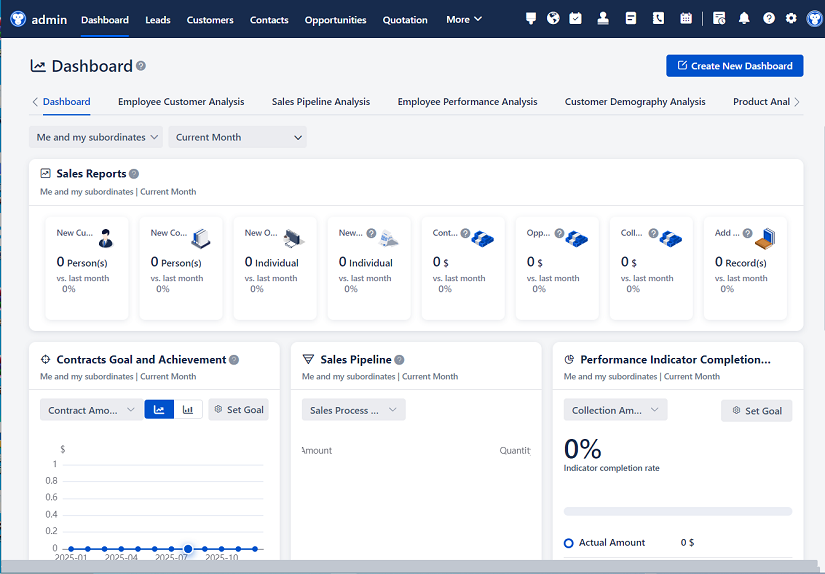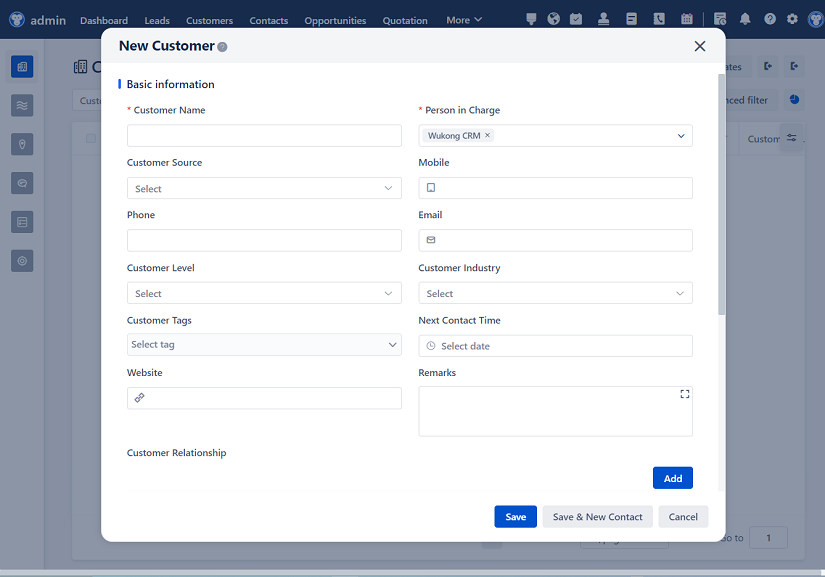
△Click on the top right corner to try Wukong CRM for free
You know, when I first started working with CRM systems, I didn’t really think much about naming conventions. I mean, how hard could it be to name a field or a custom object, right? But then I ran into this mess at my last job—fields named things like “Client_Info_2023_New,” “CustomerDetailsFinal_v2,” and even just “Temp.” Honestly, it was a nightmare trying to figure out what anything actually meant. That’s when I realized: naming conventions aren’t just some boring technical detail—they’re actually super important for keeping everything organized and making life easier for everyone on the team.
So let me tell you, once I got serious about consistent naming, everything changed. It wasn’t just about looking neat in the backend; it made reporting cleaner, integrations smoother, and onboarding new team members way less painful. I remember showing a junior analyst how we structured our lead source tracking fields using a simple prefix like “LS_” followed by a short descriptor—like “LS_WebForm” or “LS_Referral_John.” He looked at me like I’d just handed him the secret to the universe. And honestly? It kind of felt that way.
Free use of CRM system: Free CRM
Now, here’s the thing—there’s no single “right” way to do naming conventions. But there are definitely best practices that most companies follow, especially when they’re using big CRM platforms like Salesforce, HubSpot, Microsoft Dynamics, or Zoho. From what I’ve seen, the smartest teams use a mix of clarity, consistency, and scalability. They don’t just name things based on what makes sense today—they think ahead to how their CRM might grow in six months or a year.
One approach I really like is using prefixes to categorize different types of fields. For example, “CF_” for custom fields, “VF_” for formula fields, “PB_” for picklist values. It sounds minor, but trust me, when you’re scrolling through 50 fields trying to debug an automation, seeing “CF_AnnualRevenue_Calculated” instead of just “Calc_Revenue_Final” makes all the difference. It tells you exactly what it is and why it exists.
And speaking of clarity—avoid abbreviations unless they’re universally understood. I once worked with a company that used “ACCT_STAT” for account status. Fine, right? Except half the team thought “ACCT” meant “accounting,” not “account.” That caused confusion in reports and even led to a few misrouted customer emails. Lesson learned: spell it out if there’s any chance of misunderstanding. “Account_Status” takes two extra seconds to type but saves hours down the line.
Another thing people overlook is case sensitivity. Most CRMs don’t care if you use camelCase, PascalCase, or snake_case—but your team will. Pick one style and stick with it. At my current company, we use snake_case because it’s easy to read and works well across different systems. So instead of “NextFollowUpDate,” we go with “next_follow_up_date.” Simple, clean, and everyone knows where the words start and stop.
Oh, and don’t forget about length. Some CRMs have character limits on field names—Salesforce, for instance, caps custom field names at 40 characters. So while “Estimated_Close_Date_For_Q3_Leads_From_Paid_Search” might sound descriptive, it’s way too long. We trimmed it down to “est_close_date_q3_paid_search_lead”—still clear, but fits the limit.
Now, let’s talk about branding. You’d be surprised how many companies slap their brand name into every custom object or field. Like, “Acme_Client_Score” or “Acme_Loyalty_Tier.” Sounds harmless, right? But what happens when you rebrand, get acquired, or want to reuse that logic in another division? Suddenly you’ve got outdated names everywhere. A better move? Only include the brand when it’s truly necessary—like in branded campaigns or partner-specific workflows. Otherwise, keep it neutral so your CRM stays flexible.

When it comes to actual CRM platforms, each has its own flavor. Take Salesforce—it’s super powerful, but man, the naming gets wild if you don’t control it. I’ve seen orgs with “Opportunity_Staging__c,” “Opp_Stg__c,” and “Stage_Opp__c” all doing similar things. Chaos. The best Salesforce shops I’ve worked with use a strict naming standard: object names end with “__c,” custom fields include a functional prefix, and automation rules are labeled with purpose and date, like “AUTO_Update_Lead_Score_2024.”
HubSpot, on the other hand, tends to be more user-friendly out of the box. Their default property names are pretty clear—“company_name,” “deal_stage,” “num_conversion_events.” But once you start adding custom properties, it’s easy to slip into bad habits. I’ve learned to use descriptive but concise names like “lead_origin_channel” or “customer_tier_level.” No fluff, just function.
Microsoft Dynamics? That one’s a bit more enterprise-heavy. A lot of companies use underscores and full words, like “Customer_Service_Ticket_Status.” It’s verbose, sure, but in large organizations with tons of stakeholders, clarity trumps brevity. I’ve also noticed that Dynamics users often include department codes—like “MKT_Event_Response_Date” or “SVC_Case_Priority_Level.” It helps different teams filter what matters to them.
Zoho CRM feels a little more casual. Smaller businesses tend to use simpler names—sometimes too simple. I’ve seen fields called “Notes2” or “OldEmail.” Not helpful. But when Zoho teams adopt a naming convention early, they do great. One client used “SRC_” for source tracking, “TIER_” for segmentation, and “FLW_” for follow-up flags. Clean, scalable, and easy to teach new hires.

And let’s not forget about third-party tools that integrate with CRMs—like marketing automation platforms, help desks, or analytics tools. Their naming can bleed into your CRM, so it’s worth setting ground rules. For example, we decided that any field synced from Mailchimp would start with “MC_,” like “MC_Last_Campaign_Opened.” That way, everyone knows it’s external data and treats it accordingly.
One thing I always recommend is documenting your naming convention somewhere accessible—like a shared wiki or internal playbook. It doesn’t have to be fancy. Just a quick guide that says, “We use snake_case. Custom fields start with CF_. Picklists use PB_. Dates include _date. Avoid abbreviations unless standard.” Then link to examples. I’ve found that teams are way more likely to follow rules when they’re written down and easy to find.
Also, schedule regular audits. Every quarter, we spend an hour reviewing new fields and objects added to the CRM. Are they following the convention? Do any names need cleaning up? It’s like digital spring cleaning—keeps the system healthy and prevents tech debt from piling up.
Now, about brand lists—those matter too. If you’re tracking competitors, partners, or key clients in your CRM, having a standardized list helps avoid duplicates and inconsistencies. I once saw “Google,” “Google Inc.,” “Google LLC,” and “google.com” all in the same account list. Yikes. We cleaned it up by creating a master brand list with official names, common aliases, and industry tags. Now, when someone adds a partner, they pick from the list—no free typing allowed.
Some companies even use CRM labels or tags to group brands by category—like “Tech Partners,” “Agency Vendors,” or “Key Clients.” That makes filtering and reporting way easier. Plus, it reduces the temptation to create redundant fields just to track the same info differently.
And hey, don’t underestimate the power of training. When I onboard new sales reps or marketers, I spend 15 minutes explaining our naming logic. Not because they’ll be building fields, but because understanding the structure helps them use the CRM better. They learn to recognize which fields are automated, which are manual, and where to find the data they need.
Look, I get it—naming conventions sound boring. But they’re like seatbelts: not exciting until you realize how much trouble they save you. A well-named CRM is easier to search, safer to modify, and more reliable for reporting. It builds trust in the data, and that’s priceless.
So if you’re setting up a CRM or cleaning up an existing one, start small. Pick a naming style. Write it down. Share it with your team. Enforce it gently but consistently. Over time, you’ll see fewer errors, faster troubleshooting, and smoother collaboration.
And who knows? Maybe one day, someone will look at your neatly organized field list and say, “Wow, this is actually easy to understand.” That’s the dream, right?
FAQs (Frequently Anticipated Questions):
Q: Should I include the year in field names, like “Revenue_2024”?
A: Generally, no. Hardcoding years makes fields obsolete fast. Instead, use dynamic labels or store the year as a separate value in a date or number field. That way, the same field can be reused year after year.
Q: What if my team disagrees on naming style—camelCase vs. snake_case?
A: Just pick one and stick with it. Consistency matters more than preference. Vote on it if you have to, but once decided, treat it like a rule. The goal is clarity, not personal taste.

Q: How do I handle legacy fields with bad names?
A: Don’t rename them blindly—you might break automations or reports. Instead, document the old names, create new properly named fields, migrate data gradually, and deprecate the old ones over time.
Q: Can naming conventions improve CRM performance?
A: Not directly, but yes indirectly. Cleaner naming reduces confusion, lowers error rates, and speeds up development and debugging—all of which make your CRM feel faster and more reliable.
Q: Should brand names be capitalized in field labels?
A: In labels (what users see), yes—use proper capitalization for readability. But in API names or backend references, stick to your naming convention (like snake_case) regardless of the brand’s official styling.
Q: How detailed should prefixes be?
A: Keep them short but meaningful. “CF_” is better than “CustomField_.” “LS_” works for lead source. Avoid overly complex codes like “USRDFLD_”—they defeat the purpose of being helpful.
Q: What’s the biggest mistake people make with CRM naming?
A: Assuming it doesn’t matter. The biggest issue isn’t bad names—it’s having no standard at all. That leads to chaos, duplication, and distrust in the data. Start simple, but start now.
Related links:
Free trial of CRM
Understand CRM software

△Click on the top right corner to try Wukong CRM for free